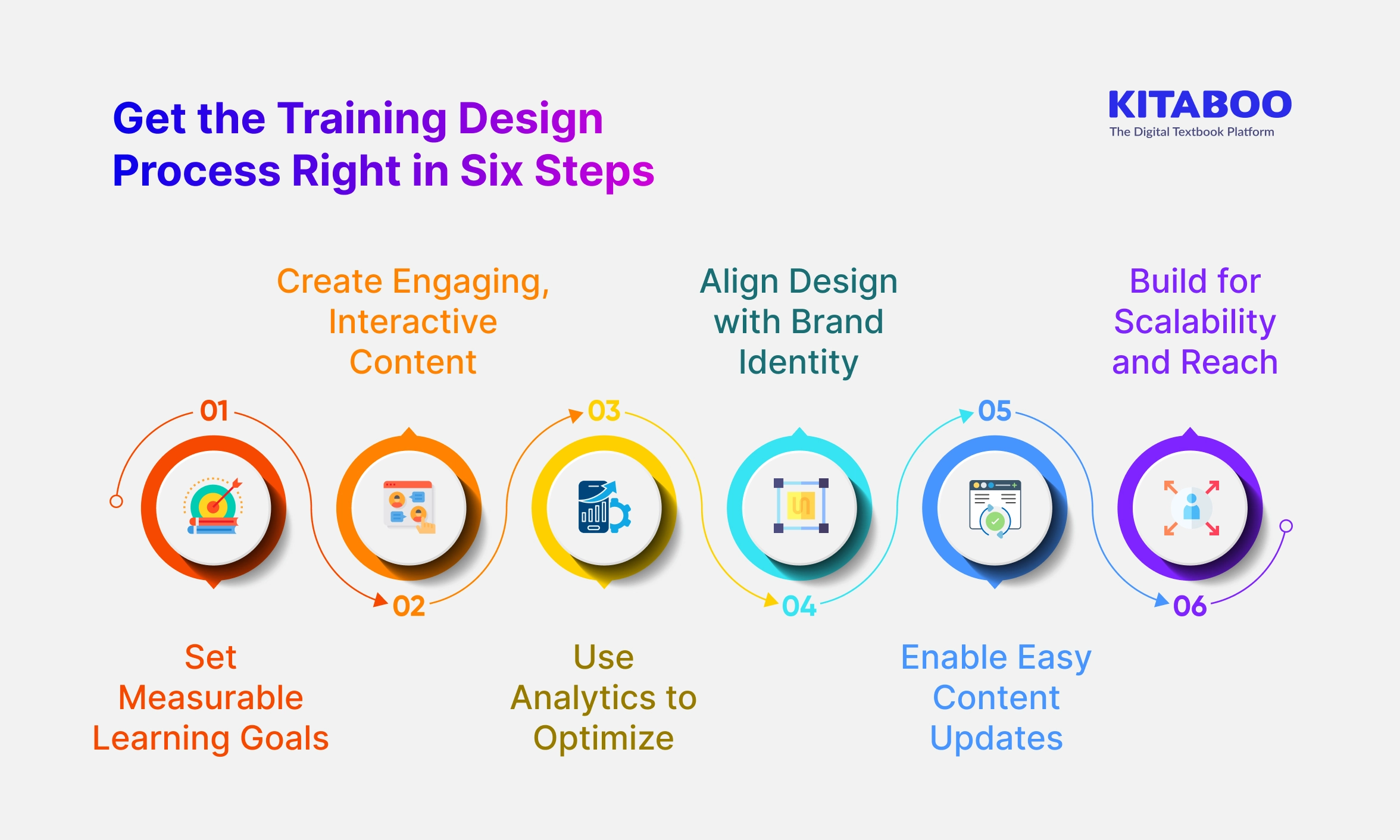
How to Implement a Successful Training Design Process
Summarize this blog with your favorite AI:
How to implement a successful training design process - TL;DR
One of the most prominent differentiators between an engaging training program and a forgettable one is the design and delivery. This puts an effective and strategic training design process at the core of training success.
Here are six proven steps you must follow for implementing a successful training design process.
- Clearly define training goals.
- Deliver engaging, interactive learning content.
- Track, monitor, and analyze progress.
- Maintain brand consistency in training content.
- Regularly update training content.
- Design for scalability and future needs.
With KITABOO, you don’t just manage this process, you accelerate it. From rapid content updates to detailed analytics and seamless branding, KITABOO gives training companies the control and agility they need to deliver results at scale. Schedule a free demo and see how your training design can do more.
“What if we train them and they leave?”
“What if we don’t… and they stay?”
This timeless insight on the importance of employee training from Henry Ford hits even harder today. Skills have become the real currency. With technological advancements, you just can’t afford to have a workforce with major skill gaps.
Training programs play a crucial role in upskilling your employees and preparing them for the future. Your business growth is directly dependent on the effectiveness of the training programs.
Are you wondering what guarantees a successful training program? The answer is simple – the training design process.
No matter how great your training content is, without a strategic design process, you are bound to fail.
Delivering static, traditional training won’t cut it today. Your training design process must ensure engagement, interactivity, and impact.
What you need is a thoughtful process of training design. But how do you implement it? Are there any tools that will make your life easier?
We’ve got the answers you are looking for.
Table of Contents
I. How Can I Implement a Successful Training Design Process?
- Define Clear Learning Goals
- Build Engaging, Interactive Training Content
- Leverage Analytics to Improve and Adapt
- Provide a Consistent Brand Experience
- Ensure Seamless and Regular Content Updation
- Design for Scalability
II. Conclusion
III. FAQs
How Can I Implement a Successful Training Design Process?
A structured process of training design helps you build impactful learning experiences. These six steps will help you get there. And yes, leveraging a robust publishing platform like KITABOO will make your life easier.
Step 1: Define Clear Learning Goals
Understanding the WHY helps. You must know why you are doing what you are doing. Understand the end goal behind every learning path and course that you are about to design.
Take a step back and simply ask yourself: What is it that we are looking to accomplish with this? Faster onboarding? Stronger compliance across teams? More confident sales reps? Better customer service?
Clarity here is instrumental. Understanding the why will give you the right direction. It will help you choose the right kind of content, format, and modules. More importantly, your stakeholders will align with the training from the start.
This also ensures your training efforts are measurable. Don’t set vague goals like – “We want to improve knowledge.” Or “We want to make employees more skillful.” Rather, set measurable goals like – “We want to increase completion rate by 70%.” Or “We want to increase learning engagement by 80%.”
Step 2: Build Engaging, Interactive Training Content
Modern learners have high expectations. They want training that’s not just informative but also engaging. Something that feels more like a guided experience than a lecture. You must skip the static PDFs and go for dynamic, interactive formats.
Learners expect interactive learning that makes training fun and engaging. Include interactive videos that will engage their multiple senses and improve retention. 83% of the learners prefer video-based learning to consume information over audio or text.
Furthermore, you can include scenario-based simulations for practice, case studies for real-life application, and interactive quizzes for self-assessment. Interactivity keeps people involved and involvement drives retention.
KITABOO makes this easier by supporting multimedia-rich content. You can easily add videos, assessments, clickable elements, and more. The mobile-first design also ensures your content looks and feels great across any device, making engagement effortless.
Step 3: Leverage Analytics to Improve and Adapt
You can’t improve what you don’t measure. Designing training is not a one-and-done exercise. Once your content is out there, the real work begins: analyzing performance. Are learners finishing the course? Which sections confuse them? Are people skipping key modules?
Tracking this helps you go beyond basic metrics like completion rates. You should understand what’s working and where you must improve. Analytics insights also help prove the ROI of your learning programs and employee training software, something stakeholders always care about.
With KITABOO, you get access to in-depth analytics including learner engagement, time spent on modules, completion rates, and offline usage. This allows your team to iterate and improve quickly, keeping your courses relevant and high performing.
Step 4: Provide a Consistent Brand Experience
Training content will never yield desired results in isolation. It must resonate with your goals, objectives, and brand’s identity. Approach training design as an extension of your brand.
Ensure your brand’s identity and values are reflected in your training courses. A training module that appears alien and disconnected from your brand’s visual identity will affect learner trust and engagement.
This is why design consistency must never be compromised. Be it for internal training and communication or for external client briefs. Make sure that when you are designing training courses, they always reflect your tone, style, and brand values.
Meticulously examine the colors, fonts, layouts, messaging, and the workflows of every training course you design. A professional training design process ensures branding consistency across touchpoints. It enhances trust and reflects the quality of your training services.
KITABOO supports white-labeling, allowing you to fully customize how your training is presented. From logo to layout, every aspect can match your brand or your client’s. This makes your offerings look more polished and client-ready from the start.
Step 5: Ensure Seamless and Regular Content Updation
Training content must evolve with your business. Product updates, policy changes, and new compliance mandates demand regular content revisions. But if updating your content feels like starting from scratch each time, it’s a problem.
Your process of training design should allow for quick edits, efficient distribution, and version control. Agility here reduces effort and helps you stay compliant and relevant.
KITABOO allows real-time content updates across platforms and devices. You don’t need to recreate entire modules or wait for long deployment cycles. This helps you stay current, reduce compliance risk, and deliver more value to your clients.
Step 6: Design for Scalability
You might start with a small team or department, but training needs can grow fast. You might have to soon train large teams across geographies, business units, or even client organizations. A scalable training design accounts for this growth from day one.
This means designing flexible modules that can be reused, supporting multilingual content, and ensuring seamless access across devices and locations. Scalability is what future-proofs your training program.
Whether you’re training 50 people or 50,000, KITABOO adapts seamlessly to your growth plans and delivery model. Moreover, it also supports multilingual delivery, offline access, and mobile compatibility. This makes designing training courses for a global, remote workforce a breeze.
Conclusion
Your team deserves engaging and interactive learning experiences that will help them grow. Training shouldn’t feel like a boring, forced activity.
Your process of training design will make all the difference. Whether your employees engage with the training content or simply skip it will depend on the effectiveness of your design process.
You must leverage smart platforms that will do most of the heavy lifting. KITABOO supports faster content creation, learning insights, and a consistent brand experience across devices. It proves to be the best ally in your quest to deliver a better learning experience.
The training landscape is evolving, don’t let outdated training design processes hamper your progress. Partner with KITABOO and redefine your workforce training programs.
FAQs
Training design can help you align the learning programs with your business goals. Without effective design, you risk delivering training that doesn’t resonate with employee skills and business requirements.
Follow the steps laid out in this blog. First, define your learning goals and map the training courses with business objectives. Focus on creating and delivering interactive learning content. Use robust platforms like KITABOO to make the process easy and effective.
Learning goals, business objectives, target audience, employee KPIs and KRAs, training delivery mode, training budgets, timelines, resource strength, and employee skills gaps.
Discover how a mobile-first training platform can help your organization.
KITABOO is a cloud-based platform to create, deliver & track mobile-first interactive training content.




